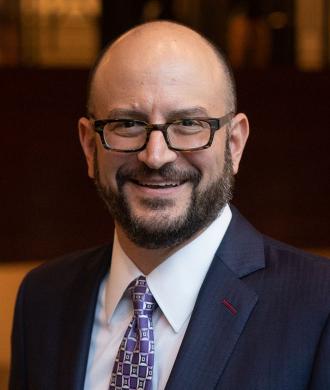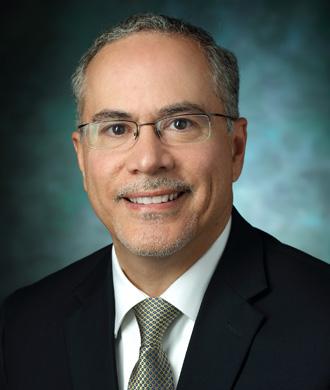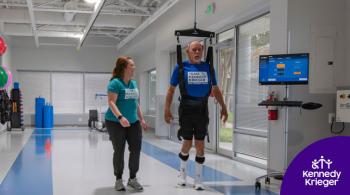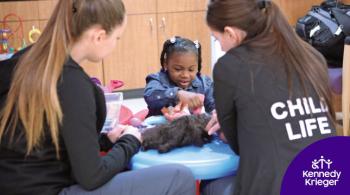Autism, Co-Morbidities and Severe Behaviors
On this episode of Your Child's Brain, Autism, Co-Morbidities and Severe Behaviors are discussed.
Guests include:
- Dr. Connie Smith-Hicks, pediatric neurologist at Kennedy Krieger
- Dr. Daniel Hoover, clinical child and adolescent psychologist at Kennedy Krieger
- Dr. Louis Hagopian, Director of the Neurobehavioral Unit at Kennedy Krieger
Learn More About Our Featured Speakers
Learn More About Our Featured Speakers
View Episode Transcription
Brad Schlaggar (BS): Welcome to Your Child's Brain, a podcast series produced by Kennedy Krieger Institute with assistance from WYPR. I'm Dr. Brad Schlaggar, pediatric neurologist and President and CEO of Kennedy Krieger Institute. Today we will be discussing autism building on last month's episode devoted to definitions, epidemiology, early diagnosis and intervention. Today, we will be discussing causes of autism and also behavioral and mental health challenges experienced by some individuals with autism. I'm joined today by Doctors Connie Smith-Hicks and Dan Hoover and Louis Hagopian. Dr. Smith-Hicks, a pediatric neurologist is the Medical Director of the Center for Autism and Related Disorders at Kennedy Krieger Institute, and is an Assistant Professor of Neurology at the Johns Hopkins School of Medicine. Dr. Hoover is a child and adolescent psychologist at the Center for Child and Family Traumatic Stress at Kennedy Krieger and is an Assistant Professor of Psychiatry and Behavioral Sciences at Johns Hopkins. Dr. Hagopian, a behavioral psychologist, is the Director of the Neural Behavioral Unit at Kennedy Krieger and is a Professor of Psychiatry and Behavioral Sciences at Johns Hopkins. Welcome Connie, Dan and Louis. Now, before we get started, I'd like to again acknowledge that in the autism advocacy community, there are differing perspectives on how best to use language. Some prefer identity-first language, she is an autistic person. Others prefer person-first language, he is a person with autism. At Kennedy Krieger, we recognize and respect these perspectives and take no position on which form of language is preferable. We think that the most inclusive and respectful approach is to use the language interchangeably and whenever possible, ask an individual how they would like to be identified. Another important level set is to say that the diagnosis of autism does not equate to illness, so today we are not focusing on autism per se, but rather individuals with autism who are seeking help and care. Let's get started. We've got a lot to cover in a short amount of time. Let's begin with the question, is autism a neurological, mental health, or behavioral genetic developmental disorder and what is the difference? Perhaps each of you can start out by giving some experience patients that you've seen or perspective on the heterogeneity. Maybe we can start out with Louis.
Louis Hagopian (LH): Sure. Our neurobehavioral programs are designed specifically to treat challenging behavior experienced by children with autism, intellectual disabilities. These problem behaviors include things such as self-injury, aggression, property destruction. We have a very comprehensive approach to treatment, we try to understand the behavior, why it's occurring and then work on developing a treatment to teach the individual new skills and help their caregivers learn how to better manage these behaviors. I think one good way to describe our program and the nature of the problems that we treat is to tell you about a young man we served in our program named Nick. Nick was diagnosed with autism and had moderate intellectual disability. His parents described him as an easy going kid. Around the time he became a teenager, he started to develop severe self-injury, he would hit his head very hard when he became frustrated and angry. Eventually that behavior became worse and included aggression. He was difficult to manage. These problems impaired his ability to function at school. He resulted in injuries to himself and others. His parents did the best they could to manage him, they had him see specialists but, eventually he had to be hospitalized. Actually, he was hospitalized five times prior to coming to our program. When he came to us, he had to be transported by ambulance because he was so unsafe and difficult to manage in the car. When he was admitted to our program, we did a number of behavioral psychiatric assessments, try and understand why he was engaging in these problem behaviors. Our assessment showed he had problem behavior when he became frustrated and was unable to solve problems and communicate his needs. We put together a comprehensive treatment that included teaching him problem-solving skills, improving his communication skills and teaching him to to tolerate life's everyday frustrations and it included medication to help control his impulsivity and mood dysregulation. When he returned home, he had a very good outcome, he actually became an accomplished artist, an entrepreneur, he started a business with his mother and has sold his art work to support charitable causes including our own program and has a career as an artist. Not everyone we treat has that outcome. In fact, everybody we treat is very different. Each bring different challenges, different skills and each has a different treatment. These behavioral problems are very heterogeneous. Our assessment really is focused on trying to understand what is happening with that particular child and family, so we can design a highly individualized treatment to serve their needs.
BS: Dan, maybe you can take the next crack?
Dan Hoover (DH): Yes, yeah. I really love that story Louis about your patient that you saw and reminded me a little bit of some of the patients that we see in our Center for Child and Family Traumatic Stress. We have children with autism and also some other developmental disorders who have been subject to, maybe not so much be having behavior problems like you mentioned, but subject to maltreatment and child abuse. Some of our kids have really had a lot of bullying and bad treatment from others, ostracism and teasing by their peers and it's really shaken them up, it can be highly distressing. Our work has really been focusing on understanding that, helping them and their families to understand how traumas impacted them and getting better and feeling better, less distressed and really focusing on their mental health more than anything else.
BS: Thanks Dan. Connie, would you like to comment?
Connie Smith-Hicks (CSH): Absolutely, thanks Brad. I would agree with Dan and Louis, autism is complexed. It's brain-based and its features become noticeable early in life when the brain is growing and changing in response to experience and it's for that reason that I would use the term neurodevelopmental. The patients that I see generally fall into two broad categories. There are those who have experienced developmental regression that may affect their language, their motor skills or their behavior and then there are those who have had a plateau in their development despite intensive early intervention. They may either no longer acquire skills or there may be significant slowing in the rate at which they acquire skills. Now, some of the questions that I get asked by parents is, is this autism? Are we missing something? Or should we be looking more closely at the brain? These are really excellent questions because we know that developmental regression can be associated with epilepsy. Sometimes we see the regression before a classic seizure emerges, so this then gives us an opportunity to intervene. Some of the patients that I see have what we call syndromic autism, whereby the autism occurs in association with other childhood and neurologic conditions, or structural differences in how other organs in their bodies are formed. In general, when parents come to see me, they wish to know the cause for their child's challenges, or they may be interested in knowing the risk for having another child who is equally affected.
BS: Lately there's been a lot of discussion about genetic contributions to autism. Picking up on that last set of points you've made, can you talk a little bit more about what it means to have a genetic contribution and how that relates to this syndromic form of autism? How they're identified, or diagnosed, and then the thought process that parents often have to go through when it comes to the consideration of genetic testing.
CSH: Absolutely. Insights into the genetics of autism really came out of twin studies back in the 1970s. In those studies that concordance rates for autism in identical twins was about 80 percent, and the corresponding rates in fraternal twins was between 30 and 40 percent. It's this finding that really supported the idea that autism is heritable and has a strong genetic basis. Since then there's been tremendous growth in our understanding of the genetics of autism. But we have also learned that social behaviors are both complex and diverse. Much of this diversity results from genetic variations between individuals and the interplay between genes and the environment. I must say that there are no autism genes. We have over 200 genes that confer risk for autism and the number of these genes continue to grow. When we do see a genetic cause, what we note is that the autism is seen in association with other medical conditions and that's when we use the term syndromic autism. Some of the common genetic syndromes that we see would be fragile X syndrome, Rett Syndrome, tuberous sclerosis, Phelan-McDermid syndrome and syngap1-related ID or some genetic disorders that are associated with autism. These are all caused by variance or changes in these single genes that disrupt protein function. We use the term pathogenic variants. But it's important to note that not all people with these genetic diagnoses necessarily have autism. The genes confer risk for developmental diagnosis and autism is one of the possible outcomes. You asked how are these diagnoses made? Well, unlike autism, where the diagnosis is based on clinical features alone, genetic syndromes are diagnosed based on a combination of the genetic test results and the associated clinical features. There are three main types of genetic tests that we use. There's a trinucleotide repeat that we use in the case of fragile X syndrome. Then we ask the question, are there genes that are missing as in deleted rather or duplicated? Then we also look at the sequence of the letters that make up the gene. A few points I want to make regarding risk benefits conversations that I have with parents. I'll start by saying that although genetic testing is recommended by multiple medical associations, the American Academy of Pediatrics, the American Academy of Neurology. The decision to do genetic testing is a very personal one. I often tell parents that we all have genetic variability and that's really what accounts for human diversity. When we do genetic testing, we're looking for rare, powerful changes that disturb gene function. While genetic tests may answer the question why does my child have autism or why does my child have cognitive difficulties? Knowing the cause for, say, Johnny's autism doesn't change who he is. It might however, tell us if he's at risk for other medical actionable conditions. That allows us to provide some anticipatory guidance. Now sometimes we see what's called an incidental findings or variants of uncertain significance. The uncertainty that's associated with these results can often be very stressful for parents and some really do an opt-out of testing for that reason.
BS: Connie, that's a great introduction to the considerations around genetics and genetic testing. There's much more to unpack there, I know. I think we should move on to address some of the questions around those conditions that can go along for the ride with autism. Dan, let's start with you that we often talk about co-morbidities or co-occurring disorders. What are they and when do they become apparent?
CSH: Well, there are a number of co-occurring disorders that can go with autism or that people with autism experience. I may stick to the mental health ones in particular. We know, for example, that many people with autism have a higher likelihood of experiencing anxiety and anxiety disorders and at a much higher rate than non-autistic people do. That's one. Another is mood changes, depression, attention deficits, and various kinds of anxiety. The gamut, the range of different kinds of mental health disorders that can present in autism are really vast. Sometimes they really depend on the person or the child's experience. They're not necessarily autism specific, but they have had experiences that make them more sensitive to what's going on. For example, being attuned to certain sensory experiences that can really set a person on edge. Sometimes our school systems, our school classrooms are not particularly well-suited to kids with autism and so they get more anxious with all the people and the crowding and the noise and so on. That's just an example of some of the inputs that can lead to further anxiety. There are a number of co-occurring things in addition to post-traumatic stress disorder, where there are actual insults or harms that are done, that a person carries and has a hard time forgetting about, maybe plagued by intrusive thoughts or memories of what happened and have a hard time getting that out of your mind and feeling better. Those are some of the co-occurring.
BS: Louis, this is a developmental disorder context. These co-occurring conditions, do they themselves have a developmental profile? Do we see them emerging at a certain time points during development?
LH: Problem behavior can emerge at anytime. Some findings show that they are more common among adolescents and they tend to decrease into adulthood.
BS: In terms of anxiety and some of the points that Dan was making about other behavioral mental health issues in addition to the problem behaviors. Or Dan maybe you want to take that in terms of the developmental time course for anxiety showing up in autism?
DH: Yes, it can show up quite early. Just as Louis was saying about behaviors, anxiety can show up early. It's very different from person to person, so I don't think there's a really good predictive time frame that we have about when they might start, but sometimes very early.
BS: Do you have a way of thinking about why anxiety and autism are so connected?
DH: As I mentioned, I think autism can enhance a person's sensitivity and sensitivity to interpersonal situations, sensitivity to certain inputs and sensations like sound and vision and tactile sensations. Then there can be a certain one-minded, single-minded style that some people with autism have. It can be really hard to be in a setting where everybody is doing their own thing and it doesn't seem to follow the rules. It can be highly upsetting if you need things to be sane and quiet and relatively well-managed. It's just life isn't like that. Anxiety set in early depending on how much exposure there is to those things.
BS: Louis, let's unpack maybe other psychiatric co-occurring conditions. How common are they and how do you go about identifying them and treating them?
LH: Identifying psychiatric problems in children with autism can be challenging because sometimes we see problem behavior that is related to events in the environment, skills deficits, et cetera, and other times it is related to a psychiatric condition and teasing that apart can be a challenge. That's one of the things we focus on when we're assessing problem behavior in the patients that we serve, we try to conduct both behavioral and psychiatric assessments to try to delineate which is going on so that we can apply the most appropriate treatment.
BS: You mentioned the problem behaviors, behavioral issues in general. How how often is it the case that self-injurious behaviors or other problem behaviors are part of the autism clinical profile? It is very common or rare or where does it fit into that spectrum?
LH: The estimates for the prevalence of problem behavior in autism do vary widely, but generally, we're talking about 50 percent of individuals with autism have some type of problem behavior. Now, individuals without autism with intellectual disabilities, also have problem behavior, but the presence of autism is a known risk factor. There's a higher probability of problem behavior. Problem behavior includes a variety of things. I mentioned self-injury and aggression. Individuals also experience other problems, including destructive behavior, elopement, which can be very serious, which is simply wandering off without a caregiver being aware. That's resulted in some significant problems. It could result in death, unfortunately. We also see individuals with pica, which is the ingestion of things that should not be eaten, and that also, obviously, can be very risky, can lead to poisoning, it can lead to internal injury and even death. We also see a lot of avoidance and non-compliance. Sometimes it's associated with anxiety and sometimes individuals are just avoiding things. It's a problem when they avoid essential activities, such as doing schoolwork or activities that are essential to their daily living.
BS: When you see self-harm, how do you go about treating it? What's the approach? Is it medication, behavior, combination of the two?
LH: There's no single treatment, but there is an approach that we espouse, both within our outpatient programs and our in-patient program. It's really focused initially on trying to understand why the behavior occurs. Self-injury as well as other problem behaviors vary widely across individuals. We see differences in their frequency, the severity, the patterning in terms of how they occur across the day, whether they're cyclical, et cetera. They also occur for different reasons. The focus of functional behavioral assessment is to identify what are the events in the environment that occasion and reinforce these behaviors? What are the skills deficits that might be present that exacerbate these problems? A lot of times these other comorbidities can exacerbate problem behavior. We know that children with autism have more sleep problems. They have problems with eating, they have gastrointestinal issues that sometimes might be a source of pain or discomfort, and that can exacerbate their problem behaviors. Our approach to understanding self-injury involves trying to understand the causes, what are the mechanisms involved for this particular individual. Then once we understand that, we can apply a very targeted intervention. As a result of that approach, all of our interventions are very individualized. They vary from individual, from child to child. Some include medication if we have mood instability or anxiety or depression that we also want to target. Some are primarily behavioral if the main things going on are events in the environment and skills deficits that we can target with behavioral treatment. Even though the interventions are highly individualized, this general approach represents a uniform way we deal with these problems.
BS: Dan, you referenced earlier post-traumatic stress disorder. We know that you work in the Center for Child and Family Traumatic Stress. Let's talk a bit about how children with autism are at increased risk for being traumatized and what happens in that context? When a child with autism is traumatized, how does that play out from clinical manifestations, how do you approach it?
DH: We know that children with autism are approximately 2-3 times more likely to experience potentially traumatic events than non-autistic individuals. For lots of different reasons, it may be increased vulnerability, being targeted sometimes by peers and others, having lots of adverse experiences as part of their life, unfortunate life experiences happen. They can be very sensitive to the things that have happened and hang on to those things and this repetitively play out in your mind. It's hard to get rid of. What we often notice is increased fears, avoidance of situations that were experienced as traumatic, like school or the neighborhood or certain people or events. Sometimes we have seen and the research has borne out some further regressions in previously attained milestones. Maybe some speech or ability to do adaptive skills like going to the bathroom or dressing oneself after a trauma can actually go backwards and you have a regression that's related directly to something that happened. Those things can happen. That's where parents and family members often will notice something's different and maybe something's different under certain circumstances that wasn't happening before. Then we know that sometimes trauma treatment is needed. What we've been doing is to adapt some of our evidence-based processes and therapies that we use for non-autistic individuals and adapting those for children and families who have autism and trying to present material and coping tools and strategies in the best preferred way through visual supports, stories, games. We've done a lot of our work online lately during the pandemic, so adapting some of those resources to help the families and children learn coping skills, and reduce that significant anxiety that's caused by reminders of trauma.
BS: Connie, in addition to being an expert child neurologist, you're also an expert developmental neuroscientist. Love to hear you speak to how the autistic brain is different from or maybe same as a typically developing brain. How do you view that?
CSH: There has been a lot of work done looking at brain imaging and functional connectivity in autism. There is no characteristic structural changes that we see in all individuals with autism. We do know that individuals with autism are able to learn and remember and some of them have a greater capacity for memory than non-autistic individuals. We also know that individuals who have autism are able to respond to therapies, and Dan and Louis talked about that. Therapies are able to work because it takes advantage of the brain's ability to change.
BS: Dan, I'm going to give you the last word on this one. What gives you hope? What's on the horizon?
DH: One thing that's exciting to me is that all the new research and clinical writing that's going on in the field of treating mental health problems in people with autism, 5-10 years ago, it practically didn't exist, especially around traumatic stress disorders and anxiety and depression. Now we have new studies coming out all the time that are helping inform us about how to best treat and relieve the suffering that we see and get people better.
[MUSIC] BS: Well, as is clear, autism is a very large and complex topic. It affects people throughout their lifespan. We're devoting several episodes of this podcast to the topic. In future episodes, we'll cover the middle and high school years, transition from school to work, the community life challenges and inequities that individuals with autism face, among other significant issues. Please check out our entire library of topics on Your Child's Brain at WYPR.org, KennedyKrieger.org, or wherever you get your podcasts. [MUSIC]



















